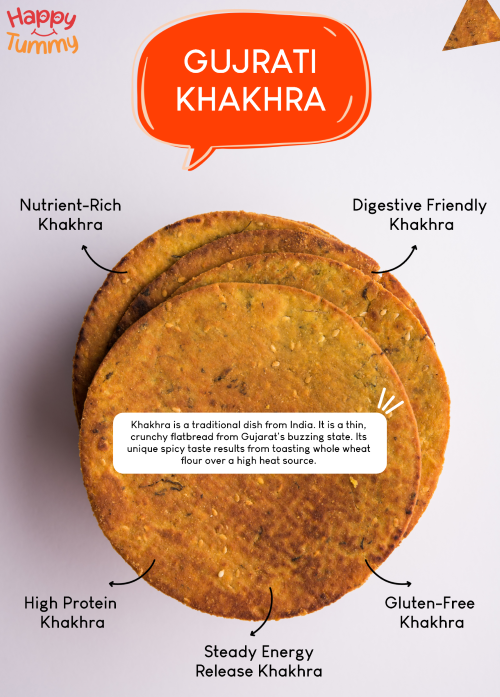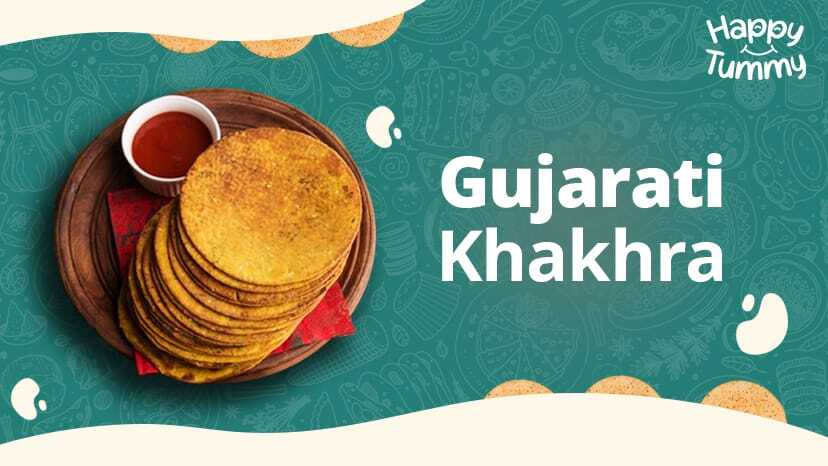Table of Contents
One of the best aspects of exploring India is experiencing diverse cuisines that showcase regional customs. Food lovers will discover a distinct fusion of tastes in each Indian snack, whether in restaurants or on the streets.
You can choose healthy and nutritious options to satisfy your tastebuds and fill your tummy, managing the need for frequent meals. Today, we will talk about Khakhra, an Indian snack from Gujarat. This low-calorie, crispy, and crunchy item pairs nicely with spicy and non-spicy food items.
You may have its bite anytime, whether for breakfast, lunch, or supper. Made with various ingredients, this Gujarati delicacy, famous across India, is enjoyable to eat. Let’s talk about how to prepare Khakhra and any potential health advantages.
Khakhra Calories
Khakhra is a traditional dish from India. It is a thin, crunchy flatbread from Gujarat’s buzzing state. Its unique spicy taste results from toasting whole wheat flour over a medium heat source. The rich flavour of the spices added to the Khakhra enhances its taste even more.
Health Benefits Of Consuming Khakhra
A key ingredient usually incorporated in Khakhra is fenugreek leaves or methi, which gives this snack a distinct fragrance and richness. You may include methi khakhra in your diet for the following reasons:

#1 Nutrient-Rich Khakhra
You might wonder what nutrients the Methi khakhra can provide. So, let’s examine the ingredients that go into its making.
Besides methi, sesame seeds and carom (ajwain) are two other ingredients that are popularly added to Khakhras to give a distinctive Indian flavour. The high fibre content in methi gives a feeling of fullness, which could help reduce overeating and lead to weight loss.
The omega-3 fatty acids, dietary fiber, and the water-soluble polysaccharide present in fenugreek called galactomannan may help in regulating digestive enzymes and also in inhibiting the absorption of glucose in the gastrointestinal tract, thus helping with blood sugar management. [1] Sesame seeds contain healthy fats, protein and antioxidants, which might benefit overall health[2].
These seeds are a storehouse of a variety of nutrients. They are often called as an “all-purpose nutrient bank”.The protein in sesame is known to be a complete protein, and the essential amino acid content ratio in them is very similar to that of the human body.
Then comes ajwain, the most common problem solver our mother’s bank upon whenever we have digestive issues. [3].The sharp-cutting flavours of ajwain have the ability to be an anti-acidic agent and help in alleviating digestive issues.
This is because the seeds of Ajwain have the potential to subside the cramping, flatulence, and any abdominal discomfort due to the presence of specific bioactive compounds. They also have a high content of antioxidants.
Moreover, whole wheat flour used to make khakra may have significant nutrients, including vitamins, minerals, and antioxidants. Also, wheat is an excellent source of B vitamins, iron, magnesium, and essential fibres, highlighting the potential health benefits of khakra[4].
Try AASHIRVAAD Fortified Chakki Atta for making Khakhra, as it is enriched with essential micronutrients like iron, folic acid, and vitamin B-12, which help combat micronutrient deficiency.
#2 Digestion-Friendly Khakhra
We often look for foods that maintain digestive health and give you a happy tummy. But in the process, you might have to compromise your taste.
But Khakhra might be an exception if you start preparing them with Multi grain flour.
The reason is that using multigrain flour, composed of two or more grains, to make this crispy delight may help increase the product’s nutritional properties as they are a good source of protein, dietary fibre, and other essential minerals. content[5].
They strive to provide essential micronutrients like Iron, copper zinc, and Vitamins especially B vitamins, from each of their individual grains, thus helping to derive a balance of nutrients so that our body receives optimum amounts of them.[6].
Furthermore, many grains in multigrain flour, such as millet, oats, and barley, may act as prebiotics. These prebiotics help nourish the gut microbiota and enhance digestive health.7].
If you plan to feed your gut with essential and good bacteria, you can munch on the Gujarati Khakhras made with multigrain flour.
With the help of a panel of knowledgeable nutritionists, Aashirvaad has created the Aashirvaad Digestive Quotient. Take this two-minute test to check your digestive quotient and see how well you’re on your path to a happy tummy. Make sure you plan your meals accurately by using your scorecard.
#3 High Protein Khakhra
When made with multigrain flour and Sesame seeds, Khakhra may become a protein-rich snack. The healthiness of six grains—wheat, soy, chana, oat, maize, and psyllium husk—in one package may feed your spirit and keep you fresh while you run those miles[8].
The addition of sesame seeds or occasionally powdered legumes makes Khakhra a valuable protein-rich snack owing to its high protein content. The 21.7 g of protein in 100 grams of sesame seeds makes Khakhra a healthy option [9].
Try making Khakhra from Aashirvaad Atta with Multigrains that combine the goodness of six grains in one pack.
#4 Steady Energy Release
The main ingredient for making Khakhra is wheat flour. Be it Atta alone or Multigrain flour, complex carbs are abundant in whole wheat flour [10].
Being nutrient-dense and a rich source of dietary fibre, it provides a more lasting source of energy as it is digested slowly.
Further, making khakhra with millet flour will also help keep energy levels steady owing to the complex carbohydrates present, due to which they are digested slowly.
This is a great lunch or afternoon snack option since it can help provide sustained energy and prevent energy dumps.
So, the next time you have food cravings and feel low on energy, try munching on Khakhras.
#5 Gluten-Free
People with gluten sensitivity often look to add a variety to their diet. However, the search stops in Khakhra.
Gluten-free Khakhra can be prepared from substitute flours like rice or chickpea and may be a good option for people with celiac disease or gluten sensitivity.
You can also prepare Khakhra using the Aashirvaad gluten-free flour containing traditional grains such as Jowar and Ragi, packed with dietary fibre, iron, magnesium, and protein.
Those who have dietary limitations may easily enjoy Khakhra with these choices.
Gujarati Khakhra Recipe
After reading about the health advantages of this popular Gujarati snack, you may find yourself craving for more and more. Here’s the recipe. Have fun!
Total Cooking Time: 1-1.5 hours.
Serving Size: 10-12 khakhras, serving 3-4 people.
Ingredients
- One cup of AASHIRVAAD WHOLE WHEAT ATTA
- Half a cup of Aashirvaad Ragi Flour (finger millet)
- Two teaspoons of Aashirvaad Besan
- Finely chopped methi (fenugreek) leaves – 1/4 cup
- Aashirvaad Turmeric: 1/2 teaspoon
- One teaspoon of cumin seeds
- Carom seeds, or ajwain, 1/2 teaspoon
- Aashirvaad Iodized Salt – to taste
- Water, as required (to knead).
- One teaspoon of Aashirvaad SVASTI hi PURE COW GHEE (for dough)
- Olive oil – for roasting
Method
1. Prepare the Dough
- In a mixing dish, combine the whole wheat flour, ragi flour, besan, chopped methi leaves, turmeric powder, cumin seeds, ajwain, and salt.
- Add one teaspoon of ghee to the mixture.
- Knead the ingredients and gradually add the water to make a firm, smooth dough.
- For fifteen to twenty minutes, cover the dough and let it rest.
2. Divide and Roll
- Roll the dough into little lemon-sized balls.
- Dust one ball with whole wheat flour and roll it into a thin, round disc shape. Roll it thinly for a crispy texture.
3. Heat the Griddle
- Heat the griddle or tawa over a medium flame.
- After heating, put the disc of the dough onto the griddle.
4. Roast the Khakhra
- Once little bubbles begin to form, flip the Khakhra over.
- Using a spatula, gently press on both sides after applying a few drops of olive oil.
- Keep frying until crisp and golden brown on both sides.
- Be careful to carry out the same procedure with the remaining dough balls.
5. Cool and Store
- When putting the khakhras in an airtight container, let them cool fully.
- Savour your nutritious, home-cooked khakhras as a tasty snack or component of your weight loss regimen!
Please feel free to adjust the recipe to your own tastes by adding more herbs or spices.
Hint: Although creating a khakhra is quite easy, rolling out the dough and making it extremely thin requires some skill. If not, it won’t become very crispy, and you’ll be left with a roti rather than a khakhra. It will still taste fantastic.
Khakhra: The Ideal Snack for Munching
When it is tea time, very few options are available that are low-calorie and delicious to eat. However, Khakhra can be your munching buddy. It is the ideal snack that you can have guilt-free.
- Variety is the Spice of Life: Khakhra has many different flavours. You will be surprised to know that you can make the Khakhra by adding the ingredients and herbs that are your favourite and using flour that suits your health.
- Travel-Friendly: Khakhra is the ideal travel snack due to its lightweight and compact design. There’s nothing to complain about, just pure delight.
- Anytime, Anywhere: Khakhra can satisfy any appetite, whether for a quick breakfast, a noon snack, or a nighttime snack. It is an always-satisfying snack.
- Mix and Match: Khakhra is a good team player. It’s the perfect canvas for your culinary creativity—you can top it with fresh vegetables, soak it in yoghurt, or pair it with pickles.
The Final Say
Khakhra’s exceptional nutritional profile, flavour, and versatility make it an item that should always be in your pantry. This little substance offers many more benefits than mere sustenance.
In fact, this versatile snack never fails to satisfy cravings—whether you’re searching for a healthy snack to curb your hunger, a lighter breakfast substitute, or even the perfect travel companion to ease your hunger!
Making it is pretty simple, and you can make it the way you want with many different flour options. Either use multigrain, wholewheat, gluten-free, or multi-millet, and the Khakhras with a dash of methi, carom, and sesame will just not disappoint you.
Happy experimenting!
Frequently Asked Questions
It’s simple to make Khakhra at home. Combine besan, chopped methi leaves, ragi flour, and whole wheat flour. Form the dough into thin rounds, then cook them in olive oil on a griddle until they become crispy.
Kakhra is indeed good for you. It may be a healthy snack when prepared with whole grains and moderate quantity of oil. It offers vital nutrients and vitamins and serves a s a low calorie snack.
Khakhra goes well with curds, chutney, or even a meal like Methia Keri (hot mango pickle) or Jeera Aloo (potatoes flavoured with cumin). You may even crumble it and add it to your cuisine for added crunch.
Consider it the crispy relative of Indian bread or ordinary roti. Thus, when you eat Khakhra as a snack, you give your body some good nutrients, a little energy boost, and a delicious pleasure.
















